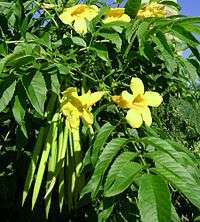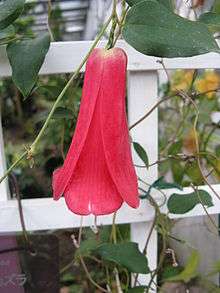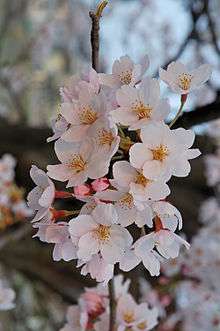Floral emblem
In a number of countries, plants have been chosen as symbols to represent specific geographic areas. Some countries have a country-wide floral emblem; others in addition have symbols representing subdivisions. Different processes have been used to adopt these symbols – some are conferred by government bodies, whereas others are the result of informal public polls. The term floral emblem, which refers to flowers specifically, is primarily used in Australia and Canada. In the United States, the term state flower is more often used.
National flowers
Africa
Mauritius
The national flower of Mauritius is Trochetia boutoniana.[1] Lotus Nelumbo nucifera.
Seychelles
The national flower of the Seychelles is Angraecum eburneum, the tropicbird orchid (known locally as orkid payanke).[2]
South Africa
The national flower of South Africa is the King Protea (Protea cynaroides).[3]
Tunisia
The national flower for Tunisia is jasmine. It was chosen as a symbol for the 2010 revolution.
Asia
Bangladesh
Water lily (Nymphaea nouchali) is the National Flower of Bangladesh.It is called 'সাদা শাপলা'(Shada shapla) in Bengali language.
Brunei
- Brunei – Simpoh Ayer (Dillenia suffruticosa)[4]
Cambodia
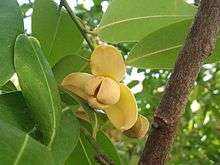
Cambodia formally adopted the romduol (Khmer: រំដួល) as its national flower in the year 2005 by a royal decree.[5] The royal decree designates the taxon as Mitrella mesnyi, however this is a taxonomically illegitimate synonym for Sphaerocoryne affinis.[6]
Hong Kong
The Bauhinia × blakeana (commonly called the Hong Kong orchid tree or "洋紫荊") is the symbolic flower of Hong Kong.
India
Lotus flower (Nelumbo Nucifera Gaertn) is the National Flower of India.[7] It is a sacred flower and occupies a unique position in the art and mythology of ancient India and has been an auspicious symbol of Indian culture since time immemorial.
Indonesia
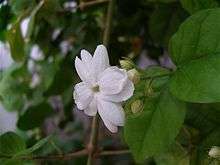
There are three types of floral emblems that symbolize Indonesia:
- the puspa bangsa (national flower) of Indonesia is melati (Jasminum sambac)
- the puspa pesona (flower of charm) is anggrek bulan (Moon Orchid, Phalaenopsis amabilis)[4]
- the puspa langka (rare flower) is padma raksasa rafflesia (Rafflesia arnoldii).
All three were chosen on World Environment Day in 1990.[8] and enforced by law through Presidential Decree (Keputusan Presiden) No. 4 1993,[9] On the other occasion Bunga Bangkai (Titan arum) was also added as puspa langka together with Rafflesia.
Melati (jasminum sambac), a small white flower with sweet fragrance, has long been considered as a sacred flower in Indonesian tradition, as it symbolizes purity, sacredness, graceful simplicity and sincerity. For example, on her wedding day, a traditional Indonesian bride's hair is often adorned with arrangements of jasmine, while the groom's kris is often adorned with a lock of jasmine. However, jasmine is also often used as floral offering for spirits and deities, and also often present during funerals which gave it its mystical and sacred properties. Moon Orchid was chosen for its beauty, while the other two rare flowers, Rafflesia arnoldii and Titan arum were chosen to demonstrate uniqueness and Indonesian rich biodiversity.
Each of the 33 provinces of Indonesia also has a native plant as its provincial flower.
Israel
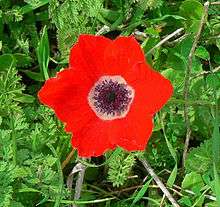
The Israeli national flower is the poppy anemone (Anemone coronaria; calanit metzuya in Hebrew), chosen in 2013 to replace Cyclamen persicum.[10][11]
Malaysia
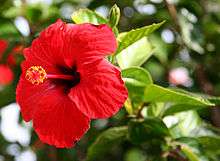
The national flower of Malaysia is the bunga raya (Chinese Hibiscus, Hibiscus rosa-sinensis).[4][12]
Maldives
The national flower of the Maldives is the pink polyantha rose (Rosa polyantha) called fiyaathoshi finifenmaa.[13]
Myanmar
- Myanmar – Pterocarpus indicus (paduak)[4]
Nepal
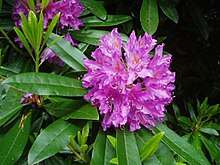
- Nepal – Rhododendron[14]
North Korea
- Korean mountain magnolia (Magnolia sieboldii) (Korean: 목란/木蘭 mongnan)[15]
Philippines
The Philippines adopted the sampaguita (Arabian jasmine, Jasminum sambac) in 1934 as its national flower because it symbolises purity and cleanliness due to its colour and sweet smell.[4] It is popularly strung into garlands that are presented to visitors and dignitaries, and is a common offering to religious images.
Singapore
- Singapore – Vanda Miss Joaquim
Sri Lanka
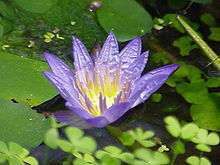
Sri Lanka – Nil mānel,(නිල් මානෙල්) blue-star water-lily (Nymphaea stellata).[16][17] Although nil means ‘blue’ in Sinhala, the Sinhalese name of this plant is often rendered as "water-lily" in English.
This beautiful aquatic flower appears in the Sigiriya frescoes and has been mentioned in ancient Sanskrit, Pali and Sinhala literary works. Buddhist lore in Sri Lanka claims that this flower was one of the 108 auspicious signs found on Prince Siddhartha's footprint.[18][19]
Taiwan
The national flower was officially designated as the plum blossom by the Executive Yuan of the Republic of China on 21 July 1964.[20] The plum blossom, known as the meihua (Chinese: 梅花; pinyin: méihuā), is symbol for resilience and perseverance in the face of adversity, because plum trees often bloom most vibrantly even during the harshest winters.[21][22] The triple grouping of stamens represents Dr. Sun Yat-sen's Three Principles of the People, while the five petals symbolize the five branches of the government.[20][21]
Thailand
The national flower for Thailand is Golden Shower Tree (Cassia fistula), locally known as dok khuen or rachapruek.[4]
Europe
Austria
- Austria – Edelweiss
Belgium
Bulgaria
- Bulgaria – Rose
Croatia
- Croatia – Iris croatica (unofficial)[25]
Cyprus
- Cyprus – Cyclamen cyprium[26]
Denmark
- Denmark – Red clover (Trifolium pratense) and marguerite daisy (Argyranthemum frutescens). The latter is often modified to oxeye daisy (Leucanthemum vulgare), a rather similar species that is native to the country (the marguerite daisy is not)[27]
Estonia
- Estonia – Cornflower
Finland
- Finland – Lily of the valley[28]
France
- France – Cornflower and marguerite daisy and Papaver rhoeas[29]
Guernsey
- Guernsey – Nerine sarniensis[30]
Iceland
- Iceland – White dryad (Dryas octopetala)
Portugal
- Portugal – Carnation, symbol of the Carnation Revolution, was a 25 of April of 1974 military coup in Lisbon which ended the, authoritarian far-right, Estado Novo Dictatorship
Slovakia
- Slovakia – Tilia
United Kingdom

- England – Tudor rose
- Wales – Daffodil, Leek
- Northern Ireland – Flax Flower, Clover Leaf
- Scotland – Thistle, Scots Pine
North America
Antigua and Barbuda
The national flower of Antigua and Barbuda is Agave karatto, also known as ‘dagger log’ or ‘batta log’.[33]
Barbados
The national flower of Barbados is the known locally as the Pride of Barbados (Caesalpinia pulcherrima).[35]
Belize
The national flower of Belize is the Black Orchid (Prosthechea cochleata)[36]
Canada
The maple leaf is widely used as a symbol for Canada. The maple tree was officially recognized as Canada's arboreal emblem in 1996.[37]
The official Provincial and Territorial floral emblems are:
- Ontario: white trillium (Trillium grandiflorum), adopted in 1937[38]
- Quebec: blue flag (Iris versicolor), adopted in November 1999[39][40]
- Nova Scotia: mayflower (Epigea repens), adopted in 1901[41]
- New Brunswick: purple violet (Viola cucullata), adopted in 1936[42]
- Manitoba: prairie crocus (Pulsatilla ludoviciana), adopted in 1906[43]
- British Columbia: Pacific dogwood (Cornus nuttallii), adopted in 1956[44]
- Prince Edward Island: lady's slipper (Cypripedium acaule), a species of orchid, adopted in 1947[45]
- Saskatchewan: western red lily (Lilium philadelphicum var. andinum), adopted in 1941[46]
- Alberta: wild rose (Rosa acicularis), also known as the prickly rose, adopted in 1930[47]
- Newfoundland and Labrador: northern pitcher plant Sarracenia purpurea, adopted in 1954. It was first chosen as a symbol of Newfoundland by Queen Victoria, and was used on the island's coinage until 1938.[48]
- Northwest Territories: mountain avens (Dryas octopetala), adopted in 1957[49]
- Yukon: fireweed (Epilobium angustifolium), adopted in 1957[50]
- Nunavut: purple saxifrage (Saxifraga oppositifolia), unanimously adopted by the Legislative Assembly of Nunavut on May 1, 2000[51]
Many Canadian flags and coat of arms have floral emblems on them. The flag of Montreal has four floral emblems. On the right side of the flag of Saskatchewan overlapping both green and gold halves is the western red lily, the provincial floral emblem. The coat of arms of Port Coquitlam has the City's floral emblem, the azalea displayed on a collar. The coat of arms of Prince Edward Island displays Lady's Slippers, the floral emblem of the Island. The coat of arms of Nova Scotia has the trailing arbutus or mayflower, the floral emblem of Nova Scotia, added when the arms were reassumed in 1929.
Costa Rica
The national flower of Costa Rica is the guaria morada (Guarianthe skinneri).[52]
Dominica
The national flower of Dominica is Sabinea carinalis, commonly known as Carib Wood or Bois Caraibe.[53]
Dominican Republic
The Dominican Republic's national flower was the flower of the caoba (mahogany tree, Swietenia mahagoni). In 2011, the mahogany was dubbed the national tree, vacating the national flower spot for the Bayahibe rose (Pereskia quisqueyana) in order to bring attention to its conservation.[54]
Guatemala
The national flower of Guatemala is the monja blanca (Lycaste skinneri var. alba).[55]
Haiti
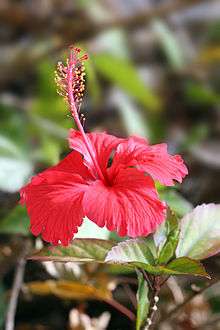
Honduras
The national flower of Honduras is the orchid Rhyncolaelia digbyana.[58]
Jamaica
The national flower of Jamaica is the lignum vitae (Guaiacum officinale).[59]
Mexico
The national flower of Mexico is the dahlia (Dahlia pinnata).
United States
In 1986 President Ronald Reagan signed legislation to make the rose the floral emblem of the United States.[60][61] In the United States, state flowers and trees have been adopted as symbols by state legislatures.
Oceania


Australia
The Acacia pycnantha (Golden Wattle) was officially proclaimed the floral emblem of Australia on 1 September 1988.[62]
French Polynesia
The Tahitian gardenia (tiare flower) is the national flower of Tahiti, French Polynesia and the Cook Islands.
Fiji
The national flower is tagimaucia (Medinilla waterhousei), a vine with red and white flowers endemic to the highlands of the island of Taveuni.
New Zealand
New Zealand does not have an official national flower, but the Silver Fern (foliage) is acknowledged as its national emblem.[63] The Kowhai (Sophora spp., native trees with yellow cascading flowers) is usually regarded as the national flower. Other plant emblems are: Koru (a curled fern symbol) and the crimson-flowered Pohutukawa (Metrosideros excelsa), also called New Zealand's Christmas tree.
Tonga
The heilala (Garcinia sessilis) is Tonga's national flower. The name of Tonga's beauty pageant, the Heilala Festival, is taken from this flower. Resorts, as well as products, are also often named after this flower, such as the Heilala Lodge and Heilala Vanilla. The flower is also used in Tonga for medicinal and ornamental purposes.
South America
Argentina
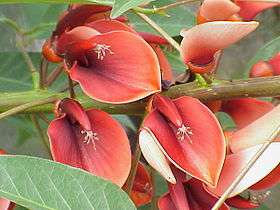
The national flower of Argentina is the flower of the ceibo tree (Erythrina crista-galli), also known as seibo or bucaré[64]
Bolivia
Bolivian national flowers are the kantuta (Cantua buxifolia) and patujú (Heliconia rostrata).
Brazil
The national flower of Brazil is the flower of the Golden Trumpet Tree (Handroanthus albus).
Colombia
Cattleya trianae is the national flower of Colombia and is the orchid which flowers in May. The May flower was chosen because the colors are the same as those of the Colombian flag.
Guyana
- Guyana – Victoria regia lily
Peru
The national flower of Peru is the cantuta (also spelled kantuta or qantuta, from Quechua qantu). It can be found at the high valleys of the Andean territory, in Peru and Bolivia.
Paraguay
- Paraguay – Mburucuyá
Suriname
Called faya lobi ("fiery love") in Sranantongo, the ixora coccinea is a commonly considered a symbol of Suriname.
Venezuela
- Venezuela – Flor de Mayo (Cattleya mossiae, an orchid)
Subnational flowers
| Country | Subdivision | Name | Pictures | Notes |
|---|---|---|---|---|
| Alberta | Wild Rose[65] | |||
| British Columbia | Pacific Dogwood | |||
| Manitoba | Prairie Crocus | |||
| New Brunswick | Purple Violet | |||
| Newfoundland and Labrador | Pitcher plant | The pitcher plant was officially declared as the provincial flower in 1954, but had appeared on the colony's coinage as early as the 1880s. It can be found in the marshlands of the province feeding on insects that fall into its leaves and drown. | ||
| Northwest Territories | Mountain Avens | |||
| Nova Scotia | Mayflower | |||
| Nunavut | Purple Saxifrage | |||
| Ontario | White Trillium |  |
||
| Prince Edward Island | Pink Lady's Slipper | |||
| Quebec | Blue Flag Iris | The Blue Flag Iris replaced the Madonna Lily in 1999, since the lily was not native to Quebec. | ||
| Saskatchewan | Western Red Lily | |||
| Yukon | Fireweed |  |
||
| Småland | Linnaea borealis | The Swedish botanist Carl Linnaeus, sw. Carl von Linné (1707–1778), often called the father of taxonomy or "The flower-king", was born in Älmhult in Småland. He gave the Twinflower its Latin name based on his own (Latin: Linnaea borealis), because of his particular fondness of it. The flower has become Småland's provincial flower. | ||
| Bauhinia blakeana | .jpg) |
The blossom, native to the territory was chosen as the logo of the Urban Council in 1965 and was later incorporated into the flag and emblem of the Hong Kong Special Administrative Region of the People's Republic of China after the 1997 transfer of sovereignty. | ||
| Nelumbo nucifera |  |
A stylised depiction of the flower can be seen in the territory's flag. | ||
| County Offaly | Bog-rosemary[66] | 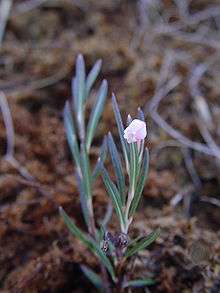 |
||
| Neeli Gulmohur Hybrid tea rose |
_na_entrada_da_cidade_de_Jardin%C3%B3polis_-_panoramio.jpg) |
The floral emblems of the four constituting provinces of Pakistan; however, they are all unofficial and are not recognised by the new Federal Government of Pakistan. | ||
| Silver date palm tree Tulipa sylvestris |
 | |||
| Afghan pine Tulipa clusiana |
 | |||
| Indian rosewood Sadabahar |
.jpg) 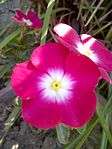 | |||
| Indian lilac tree Sindhi lotus |
 | |||
| Himalayan deodar Alpine Blue Star |
 | |||
| Chinar tree/Kashmir maple tree Snow Rose |
_en_Vanoise.jpg) | |||
| Catalonia | Weaver's Broom[67] (Spartium junceum) |
Usually along with red poppies | ||
| Galicia | Gorse flower[68] (Ulex europaeus) |
|||
Australia
- Australian Capital Territory – Royal Bluebell (Wahlenbergia gloriosa)
- New South Wales – New South Wales Waratah (Telopea speciosissima)
- Northern Territory – Sturt's Desert Rose (Gossypium sturtianum)
- Queensland – Cooktown Orchid (Dendrobium phalaenopsis)
- South Australia – Sturt's Desert Pea (Swainsona formosa)
- Tasmania – Tasmanian Blue Gum (Eucalyptus globulus)
- Victoria – Pink (Common) Heath (Epacris impressa)
- Western Australia – Red and Green Kangaroo Paw (Anigozanthos manglesii)
Norway
- Lily-of-the-valley was chosen as the county flower of Østfold[69]
- Globe flower is the county flower of Troms[70]
Pakistan
- Islamabad Capital Territory – Hybrid Tea Rose (All Varieties)
- Balochistan – Wild Woodland Tulip (Tulipa sylvestris)
- Khyber Pakhtunkhwa – Lady's Tulip (Tulipa clusiana)
- The Punjab – Sadabahar (Catharanthus roseus)
- Sindh – Sindhi Lotus (Nelumbo indica)
- Gilgit–Baltistan – Alpine Blue Star (Aquilegia coerulea)
- Azad Jammu and Kashmir – Pink Snow Rose (Rhododendron ferrugineum)
United Kingdom

Each of the four countries of the United Kingdom has a traditional floral emblem.
- England - officially the Tudor rose[71] or unofficially the red rose and English Oak.
- Northern Ireland – the flax, orange lily, or shamrock
- Scotland – the Scotch thistle, Scottish bluebell (harebell) or heather
- Wales - the daffodil, leek or sessile oak
County flowers
A county flower is a flowering plant chosen to symbolise a county. They exist primarily in the United Kingdom, but some counties in other countries also have them.
One or two county flowers have a long history in England – the red rose of Lancashire dates from the Middle Ages, for instance. However, the county flower concept was only extended to cover the whole United Kingdom in 2002, as a promotional tool by a charity. In that year, the plant conservation charity Plantlife ran a competition to choose county flowers for all counties, to celebrate the Golden Jubilee of Queen Elizabeth II.
Plantlife's scheme is loosely based on Britain's historic counties, and so some current local government areas are not represented by a flower, and some of the counties included no longer exist as administrative areas. Flowers were also chosen for thirteen major cities: Belfast, Birmingham, Bristol, Cardiff, Edinburgh, Glasgow, Leeds, Liverpool, London, Manchester, Newcastle upon Tyne, Nottingham and Sheffield. The Isles of Scilly was also treated as a county (distinct from Cornwall) for the purpose of the scheme. The Isle of Man was included, even though it is not a county, but a self-governing territory outside of the United Kingdom with an existing national flower: the ragwort or cushag.[72] The Channel Islands were not included.
A total of 94 flowers was chosen in the competition. 85 of the 109 counties have a unique county flower, but several species were chosen by more than one county. Foxglove or Digitalis purpurea was chosen for four counties – Argyll, Birmingham, Leicestershire and Monmouthshire – more than any other species. The following species were chosen for three counties each:
- Bog Rosemary Andromeda polifolia (Cardiganshire, Kirkcudbright and Tyrone)
- Cowslip Primula veris (Northamptonshire, Surrey and Worcestershire)
- Harebell Campanula rotundifolia (Antrim, Dumfriesshire and Yorkshire)
- Thrift Armeria maritima (Buteshire, Pembrokeshire and the Isles of Scilly)
And the following species were chosen for two counties:
- Grass-of-parnassus Parnassia palustris (Cumberland and Sutherland)
- Pasqueflower Pulsatilla vulgaris (Cambridgeshire and Hertfordshire)
- Common Poppy Papaver rhoeas (Essex and Norfolk)
In addition, Sticky Catchfly Lychnis viscaria was chosen for both Edinburgh and Midlothian, the county containing Edinburgh.
For most counties, native species were chosen, but for a small number of counties, non-natives were chosen, mainly archaeophytes. For example, Hampshire has a Tudor rose as its county flower, even though it is not a native species.
Unofficial flowers
Armenia
No plant or flower seems to be among the current official symbols.[73] Some flowering plants from the area include Althaea armeniaca, Armenian Basket, Muscari armeniacum, Armenian Poppy, Armenian vartig (vargit), and Tulipa armena.
Azerbaijan
Azerbaijan currently has no official national flower. Traditionally, various regions have different designations where national symbols are concerned. The city of Shusha named the Khari Bulbul (Ophrys caucasica) the floral emblem of the Nagorno-Karabakh.[74]
China

China currently has no official national flower. Traditionally, various regions have different designations where national symbols are concerned.
In 1903, the Qing Dynasty named the peony (牡丹) the floral emblem of the nation. The peony has long been considered a flower of wealth and honor in China.
The puppet state Manchukuo followed Japan's model of dual floral emblems: the "spring orchid" (Cymbidium goeringii) for the Emperor and the imperial household, and the sorghum blossom (Sorghum bicolor) for the state and the nation.
The plum blossom, meihua (Chinese: 梅花; pinyin: méihuā), has also been one of the most beloved flowers in Chinese culture. The Republic of China government named the plum blossom as the national flower in 1964.[20] The plum blossom is symbol for resilience and perseverance in the face of adversity, because plum blossoms often bloom most vibrantly even amidst the harsh winter snow.[20][21][22]
The People's Republic of China, which has controlled mainland China since 1949, has no official floral emblem. There have been several petitions in recent years to officially adopt one. However, the government has not taken any action yet. A poll in 2005 showed that 41% of the public supports peony as the national flower while 36% supported the plum blossom.[75] Some scholars have suggested that the peony and plum blossoms may be designated as dual national flowers. In addition, the orchid, jasmine, daffodil and chrysanthemum have also been held as possible floral symbols of China.
Ecuador
No flower has been officially declared as a national symbol. Unofficially the rose and the orchid are claimed to hold that title.[76]
Egypt
Both Blue Egyptian Lotus and White Egyptian Lotus are regarded as Egypt's national flowers, and they appear in many Ancient Egyptian paintings and monuments.
Guinea
In a 2018 public vote Vernonia djalonensis was voted as the national flower of Guinea, a decision which is currently awaiting government approval[77]
Japan
Japan's national government has never formally named a national flower, as with other symbols such as the green pheasant, which was named as national bird by a non-government body in 1947. In 1999, the national flag and anthem were standardised by law.
A de facto national flower for Japan for many is the sakura (cherry blossom), while a stylised depiction of a Chrysanthemum morifolium is used as the official emblem of the imperial family (Imperial Seal of Japan). The Paulownia blossom was also used by the imperial family in the past, but has since been appropriated by the Prime Minister and the government in general (Government Seal of Japan).
Netherlands
While the Netherlands does not have an official national flower, the tulip is widely considered to be its national flower.[78]
Vietnam
While Vietnam does not have an official flower, four plants are traditional regarded as the four graceful plants, namely: the lotus, the pine, bamboo, and the chrysanthemum.[4][79] The lotus (Nelumbo nucifera) is generally regarded as the unofficial national flower of Vietnam,[80] as portrayed, for example, on their postage stamps.[81] In Vietnamese tradition, the lotus is regarded as the symbol of purity, commitment and optimism for the future.[4]
See also
References
- "Republic of Mauritius- National Flower". www.govmu.org. Retrieved 2018-05-21.
- "The Mysterious and Exotic Plants of Seychelles | | International Magazine Kreol". kreolmagazine.com. Retrieved 2018-05-21.
- "South Africa's National Flower". www.southafrica-newyork.net. Retrieved 2018-05-21.
- "ASEAN National Flowers". Association of Southeast Asian Nations (ASEAN). Archived from the original on 20 January 2012.
- "ROYAL DECREE on Designation of Animals and Plants as National Symbols of the Kingdom of Cambodia" (PDF). Forestry Administration of Cambodia. Archived from the original (PDF) on 2007-06-30. Retrieved 2007-06-08.
- "The Plant List (2013). Version 1.1. Published on the Internet". The Plant List. July 4, 2014. Retrieved 4 July 2014.
- "National identity elements: National flower".
- "Archived copy". Archived from the original on 2011-10-31. Retrieved 2011-10-23.CS1 maint: archived copy as title (link)
- Keputusan Presiden No. 4 Tahun 1993 Archived 2012-04-02 at the Wayback Machine
- הכלנית: הזוכה בתחרות "הפרח של ישראל", ynet, November 25th, 2013.
- "'Calanit' (the anemone) crowned as Israel's national flower - National News - Jerusalem Post". www.jpost.com. Retrieved 2019-04-18.
- Lian, Michelle. "Hibiscus – Malaysia's national pride". AllMalaysia.info.
- "Archived copy". Archived from the original on 2008-09-07. Retrieved 2009-09-29.CS1 maint: archived copy as title (link)
- "Plants, Animals and Birds of Nepal". Nepal Vista. Retrieved 14 October 2013.
- North Korea Quarterly. Institute of Asian Affairs. 1988.
...Rose of Sharon is no longer the national flower, as in South Korea, but "mongnan" (magnolia). It is because [the rose of Sharon] cannot be grown for next generations with seeds, while [magnolia] can be.
- "Sri Lanka National Flower". gov.lk. Government of Sri Lanka. Archived from the original on December 28, 2008. Retrieved 2009-05-06.
- Zeylanica (Nymphaea stellata)
- "National Stats of Bangladesh". park.org. Retrieved 2019-04-18.
- "National Flower". www.mysrilanka.com. Retrieved 2019-04-18.
- Government Information Office, Republic of China - National Flower Archived 2011-08-05 at the Wayback Machine
- National Flag, Anthem and Flower
- "The Three Friends of Winter: Paintings of Pine, Plum, and Bamboo from the Museum Collection". Taipei: National Palace Museum. January 2003. Retrieved 31 July 2011.
- James Minahan. The complete guide to national symbols and emblems, Vol. 1. Greenwood Press. 2009.
- "National, Native and Popular Flower of Belgium - The Flower Expert - Flowers Encyclopedia". The Flower Expert. Retrieved 2019-04-18.
- James Minahan The Complete Guide to National Symbols and Emblems Vol.1, p. 364, at Google Books
- "Archived copy" (PDF). Archived from the original (PDF) on 2012-02-08. Retrieved 2018-06-10.CS1 maint: archived copy as title (link)
- "Nationalplanter og -dyr" [Nationalplants and -animals] (in Danish). Naturstyrelsen, Danish Ministry of the Environment. Retrieved 28 December 2019.
- "Lily-of-the-valley - Nationalparks.fi". www.nationalparks.fi. Retrieved 2019-04-18.
- https://fr.wikipedia.org/wiki/Emblème_végétal. Missing or empty
|title=(help) - "It's time nerines got more recognition". Guernsey Press. 4 April 2017.
- April 28, Alberta Norton; 2017 (2016-09-23). "Red Carnation: The National flower of Spain". Read National. Retrieved 2019-08-22.CS1 maint: numeric names: authors list (link)
- "Red Carnation: The National Flower of Spain". Helo National | All about Nations and National stuff. 2016-08-05. Retrieved 2019-08-22.
- "National Symbols". Government of Antigua & Barbuda.
- "The Yellow Elder – The National Flower of the Bahamas". The Government of The Bahamas.
- "The National Flower of Barbados". The Government of Barbados. Archived from the original on 2011-07-06.
- "National Symbols". Government of Belize. Archived from the original on 2007-10-12. Retrieved 2008-04-06.
- "Official symbols of Canada". Government of Canada. 3 March 2014. Retrieved 18 July 2015.
- "Ontario". Government of Canada. 2013-08-13. Retrieved 2015-07-18.
- "Quebec". Government of Canada. 2013-08-13. Retrieved 2015-07-18.
- "L'iris versicolore". Gouvernement du Québec. 2014-01-03. Retrieved 2015-07-18.
- "Nova Scotia". Government of Canada. 2013-08-13. Retrieved 2015-07-18.
- "New Brunswick". Government of Canada. 2013-08-28. Retrieved 2015-07-18.
- "Manitoba". Government of Canada. 2013-08-20. Retrieved 2015-07-18.
- "British Columbia". Government of Canada. 2013-08-13. Retrieved 2015-07-18.
- "Prince Edward Island". Government of Canada. 2013-09-04. Retrieved 2015-07-18.
- "Saskatchewan". Government of Canada. 2013-08-20. Retrieved 2015-07-18.
- "Alberta". Government of Canada. 2013-08-13. Retrieved 2015-07-18.
- "Newfoundland and Labrador". Government of Canada. 2013-09-04. Retrieved 2015-07-18.
- "Northwest Territories". Government of Canada. 2013-09-04. Retrieved 2015-07-18.
- "Yukon". Government of Canada. 2013-09-04. Retrieved 2015-07-18.
- "Nunavut". Government of Canada. 2013-09-04. Retrieved 2015-07-18.
- "Guaria Morada". CostaRica.Org. 2017-05-24. Retrieved 2018-05-21.
- "National Flower - Office of the President". presidentoffice.gov.dm. Retrieved 2019-04-18.
- "The Rose of Bayahibe, our national flower". Dominican Central. July 17, 2011.
- "La Monja Blanca, Flor Nacional de Guatemala | Aprende Guatemala.com". Aprende Guatemala.com (in Spanish). 2017-02-01. Retrieved 2018-05-21.
- Embassy of the Republic of Haiti: National Symbols Archived 2015-05-29 at the Wayback Machine
- Graves, Kerry A. (2002). Haiti. p. 57. ISBN 9780736869614. Retrieved 2 May 2015.
- "Flor Nacional de Honduras - Orquidea Rhyncholaelia Digbyana". XplorHonduras Honduras (in Spanish). 2012-08-16. Retrieved 2018-05-21.
- "National Symbols of Jamaica". jis.gov.jm. Retrieved 2011-12-02.
- "National Floral Emblem". American Rose Society.
- "National Flower | The Rose". statesymbolsusa.org. Retrieved 2019-04-18.
- "Australia's Floral Emblem". Australian National Botanic Gardens.
- Nationhood and identity teara.govt.nz
- "About Argentina". www.argentina.gov.ar.
- "Canada.ca".
- "Offaly (South)".
- "La Ginesta, flor nacional de Catalunya" (PDF). Retrieved 2020-03-18.
- Chorima
- Østfold
- Troms Archived 2007-03-26 at the Wayback Machine
- National Flowers of the UK Archived 2009-01-09 at the Wayback Machine, 10 Downing Street. Retrieved 12 May 2009.
- "Island Facts - Isle of Man Government -". 2007-05-10. Archived from the original on 2007-05-10. Retrieved 2020-03-18.
- "State symbols of the Republic of Armenia". Website of the President of Armenia.
- "Monument to Khari bulbul to be erected in Turkey". news.az. Retrieved 2019-04-18.
- 民众呼吁尽快确定国花 梅花还是牡丹引起激辩 (Chinese: The public calls for speedy designation of national flower; debates between plum blossom and peony) Archived 2012-04-24 at the Wayback Machine
- "Google Translate".
- O’Mahony, Jennifer (2018-06-12). "Guinea selects national flower for the first time with help from Kew Gardens". The Telegraph. ISSN 0307-1235. Retrieved 2019-11-13.
- "Visit the prettiest flower fields of the Netherlands". www.holland.com. 2015-03-04. Retrieved 2019-04-18.
- "Floral emblems of Vietnam and South East Asian nations". VietNamNet Online Newspaper. 3 November 2013. Archived from the original on 31 December 2013.
- "Symbol of Vietnam: Vietnam National flower". Vietnam Travel. Archived from the original on 2 March 2013. Retrieved 12 June 2017.
- Scott #874 and #875 show the lotus and flag, respectively, in honor of the first unified National Assembly general elections of 1976. Scott Publishing Company (2008). 2009 Scott Standard Stamp Catalogue: Vietnam. 6. New York. p. 1001., and again the flag and lotus are on the bicentennial issue Scot #3233, Scott 2008, p. 1032
External links
| Wikimedia Commons has media related to National flowers. |
- Plantlife County flowers page
- BBC coverage of the county flowers competition
- Provincial Floral Emblems of Canada - The Canadian Encyclopedia
- National Flowers
- Buzzle.com List of national flowers by country
